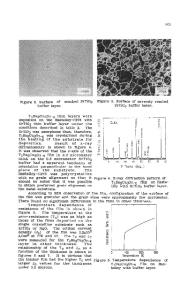Superelastic Thin Film NiTi-Polymer-Composites and Sputtered Thin-walled Tubes
- PDF / 1,091,928 Bytes
- 6 Pages / 612 x 792 pts (letter) Page_size
- 74 Downloads / 238 Views
W1.5.1
Superelastic Thin Film NiTi-Polymer-Composites and Sputtered Thin-walled Tubes Holger Rumpf1, Christiane Zamponi1, Christoph Bourauel2, Dieter Drescher3, Eckhard Quandt1 1 Center of Advanced European studies and Research, Bonn, Germany 2 Polyclinic for Orthodontics, University of Bonn, 53117 Bonn, Germany 3 Polyclinic for Orthodontics, University of Düsseldorf, 40225 Düsseldorf, Germany
ABSTRACT Superelastic shape memory materials are of special interest in medical applications due to the large obtainable strains, the constant stress level and their biocompatibility. Superelastic NiTipolymer-composites have the potential to be used for novel applications in orthodontics and medical instrumentation as well as in certain areas of mechanical engineering. Especially, using NiTi thin films these composites have the potential to substantially reduce those forces compared to conventional NiTi wires and tubes. In orthodontic applications lowering the forces during archwire treatment is of special importance due to tooth root resorption, which can be caused by the application of oversized forces. Furthermore, the use of superelastic materials or composites enables the application of constant forces independent of diminutive tooth movements during the therapy due to the superelastic plateau. Superelastic NiTi thin films have been fabricated by magnetron sputtering using extremely pure cast melted targets. Special heat treatments were performed for the adjustment of the superelastic properties and the transformation temperatures. A superelastic strain exceeding 4% at 36°C was obtained. In this paper the fabrication of superelastic NiTi thin walled tubes by magnetron sputtering is presented and their mechanical properties are compared to conventional wires and tubes in view of orthodontic applications.
INTRODUCTION NiTi shape memory alloys are well-known for their superelastic stress-strain behavior which can reach up to 10% strain in single crystals. The superelastic effect involves a stressinduced phase transformation. Upon loading the parent austenitic phase transforms into the martensite state. The detwinning of martensitic variants leads to the remarkable strain of the specimen. When the external stress is removed, the shape memory alloy returns to the austenite state and the device retrieves its previous shape [1]. NiTi is well suited for applications in the medical field since the material is known for its excellent biocompatibility [2]. The superelastic properties are often needed at 37°C which can be achieved by choosing an appropriate slightly Ni-rich composition Ti50-εNi50+ε (ε ≈ 0.7) and by thermal treatment or a certain amount of cold work. Typical applications are endoscopic instruments as well as endovascular implants [3, 4]. The fabrication of small but flexible NiTi tubes is a particular difficult task and only a relatively large homogeneous wall thickness exceeding 50 µm can be reached when using bulk materials. To fabricate endovascular devices for smaller vessels thin film techniques have to be app
Data Loading...











